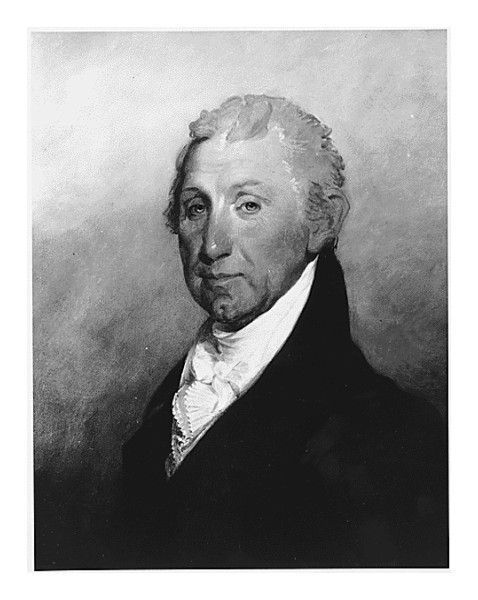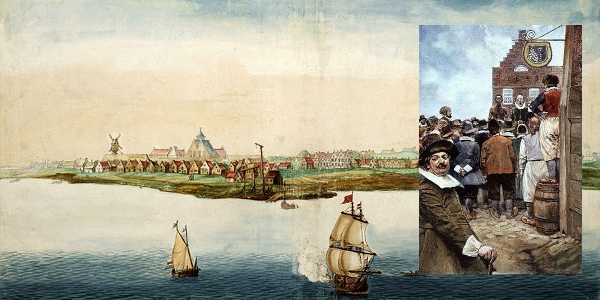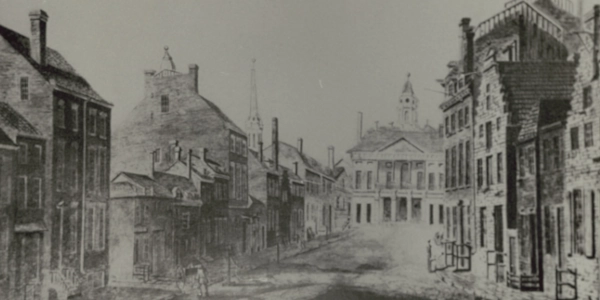
Image above: President James Monroe. Image right: Triumph, depicting eventual victory of Union, with reference to the Missouri Compromise. Created by Morris H. Traubel, 1861. Images courtesy Library of Congress.
Sponsor this page for $75 per year. Your banner or text ad can fill the space above.
Click here to Sponsor the page and how to reserve your ad.
-
Timeline
1827 Detail
July 4, 1827 - In New York State, slavery is legally abolished.

One by one, and all too late, the northern states followed the ban on importation of slavery passed by Congress in 1807 with a ban on slavery altogether. Before we get too excited about both of those important steps, it has to be recognized that after the 1807 ban, effective 1808, until the Civil War, between fifty and two hundred and fifty thousand slaves were illegally imported. However, it is also important to note the slow progress each northern state was making toward a time, in 1861, when President Lincoln could declare a Civil War on states rights, and one year later issue a preliminary Emancipation Proclamation following the Battle of Antietam. And both those were possible, ne inevitable, because of that arduously slow transition in the north, finally completed, and the lack of any transition in the south.
New York had been moving in this direction post American Revolution with the 1799 Gradual Emancipation Act that called for slavery's gradual abolition. Children born to a slave mother after July 4, 1799 were declared free when females turned twenty-five and males turned twenty-eight. For slaves born before that date, they were now classified as indentured servants and not slaves, although they still were not free. So the legislators in New York State were having a gradual epiphany while keeping free labor for their farms and mills.
It had been common practice to own slaves in New York; some historians even date slavery there to before Jamestown in 1620, reaching back to 1525 with Esteban Gomez taking fifty-eight Native American back to Portugal after he had failed to find the northern passage to China for King Charles V. Charles semi-freed them, but assigned them as servants to prosperous families. While a Dutch colony, New Amsterdam is reported to have had eleven male slaves in 1626. In 1628, three Negro women arrived. The Dutch West Indies Company was encouraging slavery, although its version was more akin to being an indentured servant, with rights to own property. In 1644, eleven Negro slaves were freed in New York, beginning the free black society of the state. But by 1655, the first slave auction was held under Dutch rule.
However, in 1664, the British took over the colony from the Dutch and their version of slavery was different, more harsh and demanding. By 1703, forty-two percent of New York households owned a slave. It would become a legally authorized activity in New Amsterdam (New York) by 1725.
Even though some of the most important men in New York's early history owned slaves; John Jay and Alexander Hamilton for two, societies amongst the free blacks living in New York, including ministers and abolitionists were joined by white abolitionists from the New York Manumission Society, founded in 1785, to push for laws that would abolish the practice.
Gradual Emancipation Becomes Permanent
On March 31, 1817, the State legislature decided to refine the 1799 Gradual Emancipation Act by passing a law, freeing the slaves who had been slaves prior to the passing of the 1799 law. They set the date of final freedom as July 4, 1827. That made New York State the first to codify a law for total abolition of legal slavery. That fact is often debated, however, with other states claiming the status as first and New York as second to last, depending on your definition. There were approximately four thousand six hundred slaves freed on that date, eleven percent of the population.
Parades, celebrations, and parties were held throughout the cities and towns as the freed men and women celebrated the end of slavery, although some still served for several years as indentured servants. The actual end of slavery in New York State did not occur until 1829 after the conditions of the 1799 and 1817 laws were met. And even after that year, the 1830 census showed that there were seventy-five slaves in the state. However, by the 1840 census, there were none listed.
The end of slavery in New York did not give black citizens the same rights as whites. At the New York Constitutional Convention of 1821, they agreed to extend universal suffrage across New York State and abolish property qualifications for white men. However, they did not extend the same suffrage rights to black citizens, continuing to make them own substantial property in order to vote.
Image above: Montage (background) Drawing of New Amsterdam, 1664, Johannes Vingboons. Courtesy Wikipedia Commons; (inset) first slave auction in New Amersterdam under Dutch in 1655, 1895, Howard Pyle. Courtesy Wikipedia Commons. Image below: Photo of a print showing the upper end of Broad Street in the 18th Century, 1950, Angelo Rizzuto. Courtesy Library of Congress. Source Info: nysarchivestrust.org; "Dating the Start and End of Slavery in New York," Ned Benton, https://nyslavery.commons.gc.cuny.edu; "When Did Slavery End in New York," Craig Landy, Historical Society of the New York Courts; nyhistory.org; "The History of the Slave in New York," Leo H. Hirsch, Jr., JSTOR; Library of Congress; Wikipedia Commons.







